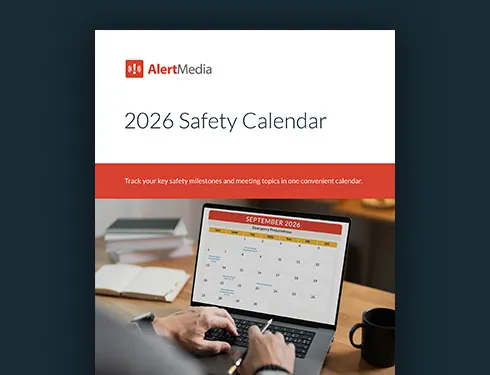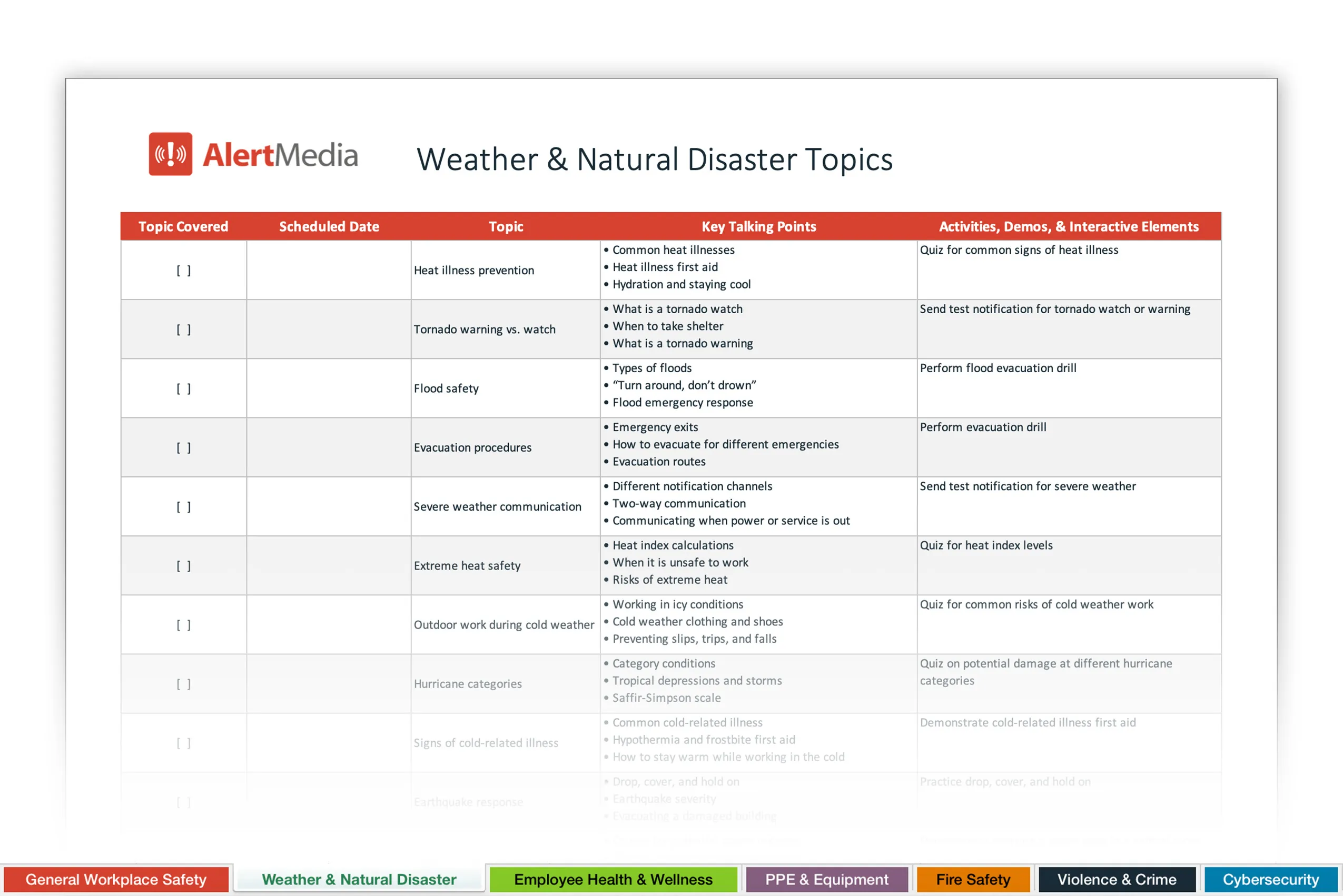
12 Monthly Safety Topics to Train All Year Round
More than half (56%) of surveyed employees admit they don’t feel completely safe at work. Safety training can help, and regular safety meetings are especially helpful in engaging employees in long-term preparedness efforts.

When a crisis hits, every second counts—and every person matters. As a safety leader, your day-to-day work builds the foundation for a stronger, safer workplace. But in the heat of an emergency, it’s not only your efforts that count—it’s everyone’s.
That’s why regular safety meetings aren’t just routine—they’re critical. They help embed best practices, reinforce emergency response plans, and increase safety engagement. By introducing fresh safety topics each time, you keep participants alert, involved, and ready—rather than zoning out on content they’ve heard before.
We’ll outline twelve monthly safety topics (and a few national safety observances) that you can use to reinforce best practices and teach your team how to stay safe. These topics cover a range of hazards and safety initiatives that can apply to any business. Whether you work in environmental health and safety (EHS), security, or a related field, you can use these topics to guide weekly or monthly safety meetings or inform the training you assign.
12 Safety Topics for Work
2026 Safety Calendar
What is a safety topic?
A safety topic supports comprehensive safety training by guiding a more focused discussion. You can address safety topics with bigger or smaller groups and tailor these discussions to teams’ unique safety concerns. When you hold safety-focused talks regularly on a variety of topics, you support broader preparedness efforts. In this way, you also cultivate an organizational safety culture, making everyone accountable for safety goals.
These safety meetings take on all different shapes and sizes depending on what an organization needs them to achieve. They also take on many names: safety moments, safety talks, safety toolbox talks, tailgate talks, safety chats, safety briefings, and others. The name you choose matters less than the content and the effectiveness of the meetings themselves. But many organizations choose a name to match the intended tone and help participants feel connected to the regular safety training commitment.
12 Safety Topics for Monthly Meetings
You can organize safety meetings around a structured format with clear checklists of procedures or other details to cover. Or you can plan safety talks with a loose structure to facilitate a discussion and challenge team members to think critically about the topic at hand. Remember that you don’t need to fit everything into one meeting; there’s always next week or next month. Sometimes, you just need a safety talk topic idea to get the conversation started. Consider using a safety meeting agenda to maximize engagement and knowledge retention.
What is the best topic for a safety meeting?
The best safety topic for work is one that supports the following:
- Your emergency preparedness, safety practices, and response readiness
- Employee buy-in for safety initiatives
- Refreshers of less-frequent safety training
- Interest and engagement in efforts that benefit employee well-being as well as the business itself
You’ll find a substantial list below of workplace safety training topics for meetings that are adaptable to your company’s identified threats, preparedness priorities, and current safety goals. But you can also develop your own list. What work-related safety topic would make the most significant difference in your team’s awareness and productivity today? How might you build on your team’s growing risk awareness and emergency readiness, one topic after another?
You might decide that everyday ergonomics is the topic for the week that will help lay the base for employee buy-in, engagement, and general well-being. Another week, you might decide to focus on hurricane communications to ensure your people know how to respond when they receive specific messages during a storm. Or you might concentrate on common OSHA violations and ways team members can support compliance.
1. January Safety Topics
Inclement weather
Inclement weather is defined as any severe or harsh weather condition that makes it unsafe or impractical to travel, commute, or work outdoors. Every region and every business faces weather-related threats and challenges, and what might be normal weather conditions in one region may be dangerous in another. Create an inclement weather policy and best practices based on the regional threats you identify.
SAFETY MESSAGE OF THE MONTH: “Inclement weather safety depends on good decisions before a storm hits. Review our severe weather procedures today.”
Guiding questions:
- What inclement weather events might disrupt your business operations?
- What should your employees do when inclement weather hits?
- What is your plan when employees cannot safely get to or leave work?
- How and when will you communicate about severe weather with your employees?
Inclement-weather safety tips:
- Plan ahead for how employees will work from home if road conditions are bad.
- Have emergency kits in the office in case people get trapped in the facility.
- Check out our full list of January safety topics.
2. February Safety Topics
Natural disasters
Often sudden and destructive, natural disasters put your people, facilities, and operations at risk. Not to mention, your employees’ families and homes are also at risk when disasters strike. These events vary wildly depending on location, and climate change increases their impacts and frequency.
SAFETY MESSAGE OF THE MONTH: “Natural disasters can escalate fast—your best defense is being ready. Take a few minutes today to refresh your knowledge.”
Guiding questions:
- What natural disasters most commonly affect your area?
- What are your evacuation plans for a disaster at your workplace?
- How will you navigate disaster recovery?
- When and how will you notify employees about predicted or imminent disasters, as well as planned responses?
Natural disaster recovery tips:
- Assign specific people to perform different recovery efforts, including communication.
- Research FEMA resources and support before an incident so you can quickly access support after a disaster.
Preview of a spreadsheet full of safety topic ideas and space for you to fill in your own
February is American Heart Month
Heart health is an important topic for all employees, as heart disease is a leading cause of death in the U.S. This month-long observance is the perfect time to discuss the topic of heart health, lead a CPR training, teach employees how to perform immediate assistance, and educate your teams on common heart conditions. Learn more about promoting Heart Health Month at the NIH website.
Watch this video to learn the fundamentals of compelling safety talks, discover new topic ideas, and get facilitation tips.
3. March Safety Topics
Health and wellness
Your employees’ health and wellness are as much a matter of workplace safety as preventing violence and responding to natural disasters are. Preventing disease outbreaks, providing ergonomic support, and preventing injuries should all be considered part of your general safety training program.
SAFETY MESSAGE OF THE MONTH: “From practicing safe lifting techniques to staying hydrated, today’s small choices can help prevent tomorrow’s injuries.”
Guiding questions:
- What is your sick-day policy?
- Do your employees know about proper ergonomics training and safe lifting techniques?
- How will your business handle a disease outbreak in your workplace or location?
- How can you support the overall health of employees?
Health and wellness safety tips:
- Walk employees through healthcare coverage options so they know what is available.
- Encourage healthy practices, including good sleep, nutrition, and exercise.

Workplace violence
The CDC defines workplace violence as any “act or threat of violence, ranging from verbal abuse to physical assaults directed toward persons at work or on duty.” Examples include physical assault, robbery, and theft or destruction of private or company property. It can be caused by a coworker, contractor, customer, or former employee, and it can happen anywhere inside or outside the office.
Guiding questions:
- What are the signs of potential workplace violence?
- Where can your employees hide if violence breaks out in your workplace?
- Who on site would need to be notified about any workplace violence?
- What specific types of workplace violence might your business face?
SAFETY MESSAGE OF THE MONTH: “Safety means looking out for one another. Stay alert for the warning signs of workplace violence and report any potential threats immediately.”
Workplace violence prevention tips:
- Improve the physical security like lighting and door access of your worksites.
- Offer situational awareness training and tabletop exercises to prepare employees in a low-stress work environment.
April is Workplace Violence Prevention & Awareness Month
Our 2024 Employee Safety Report found that nearly one in four workers have experienced workplace violence. As a safety topic, workplace violence prevention should not be on the back burner. April is a good reminder to revisit policies, reiterate expectations with employees, and clarify how the company is committed to protecting employees against workplace violence. But there should be no limits to improving awareness, prevention, and response.
April is Distracted Driving Awareness Month
The National Safety Council offers resources to help increase awareness of distracted driving risks, especially during the month of April. You are in an ideal position to guide employees in alert and defensive driving when they are on the job and off. The more awareness spreads, the safer our roads become overall.
5. May Safety Topics
Mental health
Even in the workplace, mental health consists of a person’s social, psychological, and emotional well-being, and it takes into account factors like stress management, decision-making, and thought patterns. Mental health can greatly impact the quality of life, and poor mental health can create lasting detrimental effects if not addressed. As you have conversations with your employees, explore how their mental health fits into your duty of care with active support and a conducive work environment.
SAFETY MESSAGE OF THE MONTH: “Mental health is health. Let’s create space for open conversations and support in our everyday work.”
Guiding questions:
- How will you identify and support employees struggling with their mental health?
- What benefits do you have for mental health?
- How can you encourage a good work-life balance?
- What should employees do if they are struggling with their mental health?
Mental health safety tips:
- Encourage employees to take breaks during the day.
- Train managers on how to best support their teams mentally and emotionally.
May is Mental Health Awareness Month
Participate in Mental Health Awareness Month in May by prioritizing your employees’ mental health. Consider offering extra paid time off or hosting events like meditations in the workplace. Explain what mental health support is available and how to access it should employees ever need it.
6. June Safety Topics
PPE and equipment safety
Whether it’s helmets/hard hats, reflective vests, respirators, hearing protection, face masks, or fall protection, your employees need the right personal protective equipment (PPE) to stay safe. And training for the proper use of heavy equipment and power tools, whether on the factory floor or in a company vehicle, will prevent workplace injuries and accidents.
SAFETY MESSAGE OF THE MONTH: “The right gear protects you only if you use it right. Double-check your PPE before you start work every day.”
Guiding questions:
- How often do you train employees on how to properly use their PPE, including when and how to replace damaged or worn-out PPE?
- Have there been accidents with heavy machinery or equipment? How could these incidents have been prevented?
- What hazardous materials (e.g., chemicals like radon) or heavy equipment (e.g., forklifts) are your employees working around regularly?
- What protocols should employees follow when working with dangerous equipment? (E.g., lockout tagout (LOTO), electrical safety protocols, ladder safety protocols.)
Workplace equipment safety tips:
- Check out the Occupational Safety and Health Administration’s requirements and suggestions for PPE.
- Encourage and reward employees who practice safe behavior and report potential hazards and near misses.
June is National Safety Month
In June, the National Safety Council (NSC) provides a wide range of safety resources to support National Safety Month. You can use these resources to bring employee health and safety front and center in your day-to-day. It can be as simple as hosting a safety meeting or seminar, or you can go big with a safety contest for employees. No matter how you celebrate, make sure your employees know just how much their safety matters to you and your business.
7. July Safety Topics
Heat safety
Working in extreme heat, especially in heavy protective gear, can be hazardous for workers. Even before the summer months bring heat waves, you need to commit to heat stress prevention. This is especially true as climate change brings more frequent and severe heat in many areas. As the threat of extreme rises, OSHA is putting together new regulations on heat exposure for workers, and now is the time to train your team on better heat safety procedures. It may save lives.
SAFETY MESSAGE OF THE MONTH: “In high heat, hydration and rest aren’t perks—they’re protection. Listen to your body and take breaks.”
Guiding questions:
- Do you have policies in place for extreme heat?
- What are the signs of heat illness?
- Where are your employees most likely to experience heat stress?
- Are there any interior spaces that might pose a heat risk?
Heat safety tips:
- Provide ample water and air-conditioned spaces for employees working in extreme heat.
- Encourage employees to wear breathable fabrics as much as possible.
Check out our full list of heat safety tips.
8. August Safety Topics
Fire prevention
Nearly all employees have participated in a fire drill at one point or another, but that doesn’t mean you can check fire safety off the list. Structure fires can be very destructive and cause severe harm to people and property alike—especially if employees are ill-prepared to respond. Fire safety awareness calls for regular refreshers, especially when you update procedures and evacuation routes.
SAFETY MESSAGE OF THE MONTH: “Clear hallways, safe storage, and tidy spaces—fire prevention begins with the basics.”
Guiding questions:
- Do all employees know the fire evacuation plan?
- When was the last time your workplace had its fire doors and fire extinguishers checked?
- Are employees practicing good fire safety in the office/facility?
- What are your most significant fire risks, and how can you mitigate potential impacts?
Fire safety tips:
- Run regular fire drills and revise your evacuation plan as needed based on how the exercises go.
- Assign the role of fire warden to someone on staff, and ensure this person is sufficiently empowered to take charge of workplace fire prevention tasks.
9. September Safety Topics
Emergency preparedness
Emergencies can happen at any time, so advance preparation and constant vigilance are critical to ensure your business is ready to respond. Perform threat assessments to determine the risks you should prioritize. Then develop emergency response plans, and keep your team in the loop with training and safety meetings.
SAFETY MESSAGE OF THE MONTH: “Emergencies are unpredictable—our response shouldn’t be. Let’s walk through our plan today.”
Guiding questions:
- What emergency plans do you already have, and what plans do you need?
- Who is responsible for communicating with affected employees during an emergency?
- What emergencies are good fits for running drills or tabletop exercises?
- How can you better communicate with your team when there is an emergency?
Emergency preparedness tips:
- Invest in technology like threat intelligence and an alert notification system to make your planning more manageable and more reliable.
- Use a threat matrix to quantify the threats you face and prioritize preparedness efforts and safety measures.
September is National Preparedness Month
National Preparedness Month is a great time to assess and revise your emergency preparedness plans. Involve your employees by practicing your plans—you can even use it as a team-building opportunity and create emergency kits as a group.
10. October Safety Topics
Cybersecurity
Cybersecurity often gets overlooked in the context of workplace safety, but don’t underestimate the risks to your operations and business continuity. It’s critical to teach your employees good cybersecurity practices and ensure they are set up to protect themselves and your business from cyberattacks.
SAFETY MESSAGE OF THE MONTH: “Think before you click. Cyber threats target people first, then systems. Stay alert online.”
Guiding questions:
- What are the signifiers of a phishing scam attempt?
- How will you notify employees or customers if there is a system outage due to a cyberattack?
- What can you do to mitigate the risk of cyberattacks?
- What information might be at risk?
Cybersecurity tips:
- Conduct cybersecurity awareness training and teach employees about common tactics such as phishing.
- Ensure all your employees are using strong passwords and two-factor authentication when possible.
- Frequently back up important information, and make sure you are using reputable third-party systems.
- Consider a converged security approach to improve physical and cybersecurity simultaneously.
October is Cybersecurity Awareness Month
You can use Cybersecurity Awareness Month to jumpstart your cyber preparedness efforts. Run phishing scam drills and teach your employees how to protect their data. If you don’t already have one, create a cybersecurity response plan so you are ready to mitigate the damage if an attack occurs.
11. November Safety Topics
First aid
Some emergencies will require professional medical attention, but first aid can address many common workplace injuries. Even when significant emergencies occur, you won’t always have immediate access to first responders or even managers/company leaders, so it’s essential to have people on the ground who can act quickly to respond to injuries and help mitigate harm, even prevent fatalities.
SAFETY MESSAGE OF THE MONTH: “You don’t need to be a paramedic to save a life. Learn first aid—it’s worth every second.”
Guiding questions:
- Do your employees know what hazardous situations—emergency or otherwise—might arise in the workplace?
- How many employees are trained in CPR or first aid?
- Where are first aid supplies stored in the workplace?
- Do employees know how to differentiate between the kinds of injuries that need hospital care and those that do not?
First aid tips:
- Host first aid training for employees and incentivize or even mandate participation.
- Place first aid kits around the office, clearly label them, and keep them stocked.
Holiday season safety
The holiday season brings unique safety challenges, from cold weather and electrical hazards to increased stress and distractions. It’s a good time to revisit your health and safety program, conduct a quick safety audit, and share practical winter safety tips. Encourage safe habits during holiday parties, address electrical risks, and promote wellness to help employees manage seasonal pressures. A little extra attention now can keep the season festive—and safe—for everyone.
12. December Safety Topics
Cold safety
While there is no OSHA standard for cold-weather safety, protecting your employees from cold-weather harm is an aspect of your duty of care. Implement procedures and safety initiatives to protect your team from cold-weather injuries and illnesses, including hypothermia, fall hazards, frostbite, and colds or the flu.
SAFETY MESSAGE OF THE MONTH: “Cold weather can be silent but serious. Winterize your work and watch out for each other.”
Guiding questions:
- Who is most at risk of cold-weather injuries or illness?
- What are the signs of hypothermia and frostbite?
- What is the communication plan for extreme cold or winter weather events?
- What resources can you provide to employees working outside in cold weather?
- What hazards exist on the job site that could result in slips, trips, and falls, and how do winter conditions exacerbate these hazards?
Cold-weather safety tips:
- Winterize all offices and worksites for injury prevention and suitable work environments. Clear sidewalks and parking lots of snow and ice, apply de-icing materials, and supply space heaters or generators.
- Create cold weather kits, especially for employees who might be driving in cold weather.
- Check out our full list of December safety topics.
Next Steps for Safety Engagement
With these safety topics, you can run engaging, relevant safety meetings and inform safety training programs that will actually help keep your employees safe all year long. When you make safety a priority and ingrain it into the very culture of your workplace, your employees are much more likely to know just how much you care, and they’ll make safer choices overall.








